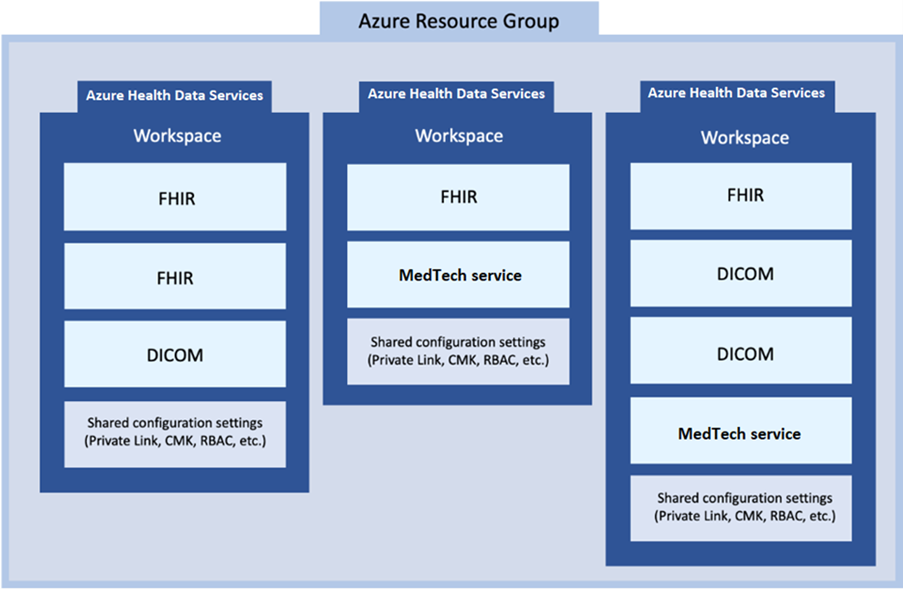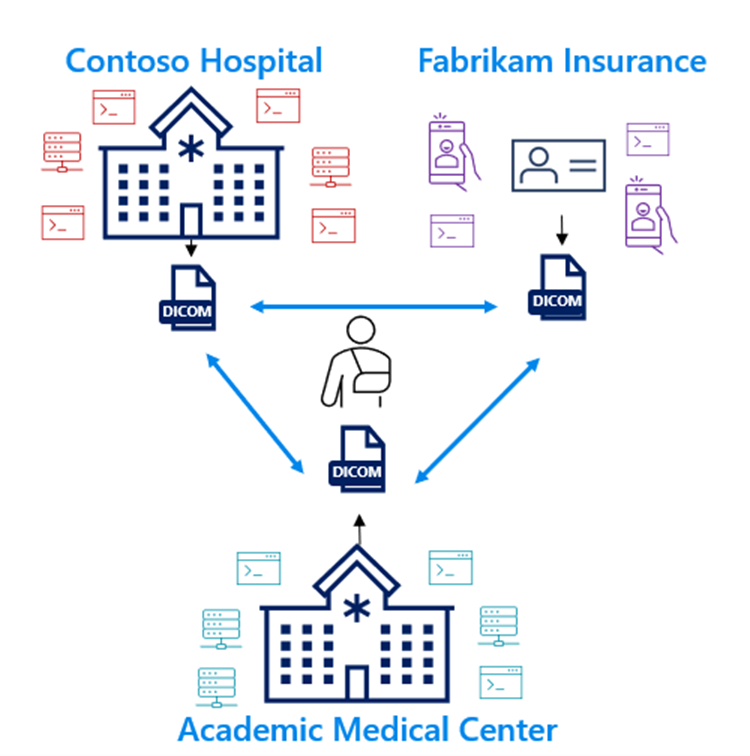Azure Health Data Services tools and connectors
Azure Health Data Services consists of tools and connectors for protected health information to allow for health and life sciences systems interoperability within and across organizations. Coordinated care, patient monitoring, alerts, and flexible care options are among the many healthcare functions that rely on data interoperability. As a result, interoperability is critical in helping solve the interoperability challenges.
The following diagram shows a high-level example of the key components of Azure Health Data services.
Azure Health Data Services workspace
The Azure Health Data Services workspace is a logical container for healthcare service instances, such as the Fast Healthcare Interoperability Resources (FHIR®) services, the Digital Imaging and Communications in Medicine (DICOM®) services, and the MedTech service.
Key workspace concepts:
The workspace creates a compliance boundary (HIPAA, HITRUST) within which protected health information (PHI) can travel.
You can configure multiple services in a workspace so that they work more seamlessly with one another.
You can create workspaces in a resource group from the Azure portal or by using deployment scripts.
Workspaces provide a single compliance boundary for authentication and authorization of users.
Workspaces offer role-based access control (RBAC) so that you can manage how data is stored and accessed.
Workspaces isolate data to a unique database for each API instance and ensure that data is more protected with multiple-region failover.
The following diagram illustrates how you might provision Azure Health Data Services in an Azure subscription.
FHIR service
The FHIR service in Azure Health Data Services allows for rapid exchange of health data by using the Fast Healthcare Interoperability Resources (FHIR) data standard. As part of a managed platform as a service (PaaS), the FHIR service helps anyone who works with health data to store and exchange Protected Health Information (PHI) in the cloud.
With the FHIR service, you can:
Ingress and egress the data into the FHIR service with high throughput.
Exchange data through consistent, RESTful, FHIR APIs based on the HL7 FHIR® specification. FHIR service offers an enterprise-grade FHIR API endpoint that's provided for efficient access to and storage of FHIR data.
Convert health data from various formats into FHIR R4 data.
Have controlled data access. The FHIR service's role-based access control (RBAC) is based on Microsoft Entra identities management. You can grant or deny access to health data based on the roles given to individuals in your organization.
Ensure more secure healthcare data. The FHIR service helps protect your organization's PHI with an unparalleled level of security. In Azure Health Data Services, FHIR data is isolated to a unique database for each FHIR service instance.
The FHIR service allows for connection with any health data system or application that's capable of sending FHIR API requests. Along with other parts of the Azure ecosystem, the FHIR service forms a link between electronic health records systems (EHRs) and Azure's suite of data analytics and machine-learning tools. As a result, organizations can build patient and provider applications that harness the full power of the Microsoft cloud.
DICOM service
The DICOM® service in Azure Health Data Services allows healthcare organizations to ingest, store, manage, and exchange medical imaging data more securely and efficiently with any DICOM web-enabled systems or applications. Health Data Services uses Digital Imaging and Communications in Medicine (DICOM), the international standard to transmit, store, retrieve, print, process, and display medical imaging information. For example, DICOM helps with the digitization of ultrasound, CT scan, MRI, and other common imaging procedures.
The following diagram illustrates how healthcare organizations use DICOM to transfer DICOM objects between entities, such as hospitals, payors, and other medical centers, for second opinions or continued care.
The DICOM data model consists of four object levels: Patient, Study, Series & Equipment, and Instance, as shown in the following image.
The DICOM service ingests and persists DICOM objects at multiple thousands of images each second. Additionally, the DICOM service helps:
Facilitate communication and transmission of imaging data with any DICOMweb™ enabled systems or applications through DICOMweb standard APIs.
Isolate data to a unique database for each API instance and help protect with multiple-region failover.
Index DICOM studies, series, and instances on standard and private DICOM tags by expanding the list of tags that are already specified in the DICOM Conformance Statement.
Access ordered, guaranteed, immutable, read-only logs of all changes that occur in the DICOM service.
Inject DICOM metadata into the FHIR service, or the FHIR server, as an imaging study resource. This feature allows for a single source of truth for clinical data and imaging metadata.
MedTech service
The MedTech service helps ingest and transform high-frequency data from Internet of Things (IoT) digital health devices into a unified FHIR format. Then, it stores the data in an enterprise-scale, more secure, and compliant cloud environment. You can use this data for monitoring, storage, analytics, and reporting of vital health information. Healthcare organizations can use MedTech service in the context of remote patient monitoring, virtual health, and clinical trials.
The MedTech service helps healthcare organizations:
Align and standardize health data from disparate devices into a common format, make sense of the data through a unified lens, and to capture trends.
Normalize and group IoT data by mapping commonalities to FHIR.
Link devices and healthcare consumers for enhanced insights and trend capture.
Use MedTech service with devices that are created and managed through Azure IoT Hub for enhanced workflows and ease of use.





